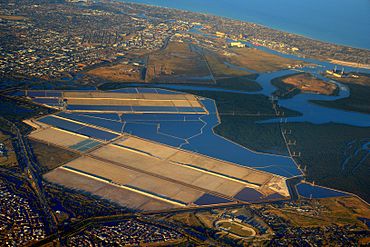Adelaide International Bird Sanctuary National Park—Winaityinaityi Pangkara facts for kids
Quick facts for kids Adelaide International Bird Sanctuary National Park—Winaityinaityi PangkaraSouth Australia |
|
|---|---|
|
IUCN Category VI (Managed Resource Protected Area)
|
|

Dry Creek salt crystallisation pans
|
|
| Established | 27 October 2016 |
| Managing authorities | Department of Environment and Water |
| Website | Adelaide International Bird Sanctuary National Park—Winaityinaityi Pangkara |
| See also | Protected areas of South Australia |
The Adelaide International Bird Sanctuary National Park—Winaityinaityi Pangkara is a special protected area in South Australia. The South Australian government created it along the northeast coast of Gulf St Vincent. It stretches from Parham in the north to the southern end of Barker Inlet in the south.
This park was created for several important reasons. It helps fix land that was once used for salt pans. It also protects the homes of many shorebirds that travel long distances across the world. The park helps manage water quality in Gulf St Vincent and creates new "green" spaces. It also supports special tourism and creates chances for Indigenous people to be involved.
This coastline has very flat land and calm waters. It features wide areas of underwater seagrass meadows, coastal mangroves, and high saltmarshes. This area is also known as the "Samphire Coast."
Contents
Why is the Bird Sanctuary Important?
The Adelaide International Bird Sanctuary was set up by the South Australian government to achieve five main goals. These goals help protect nature and create opportunities for people.
Protecting Bird Habitats
- The park protects important places where shorebirds live. These birds fly huge distances across the Earth, migrating from one place to another.
Improving Water Quality
- The park helps manage the water quality in Gulf St Vincent. This is especially important for stormwater and wastewater from the northern suburbs of Adelaide. The water is treated before it goes into the Gulf.
Creating Green Spaces
- The sanctuary creates new "green" areas on the edge of the northern Adelaide Plains. These spaces help recycle stormwater and absorb carbon dioxide. They also make the area more beautiful and enjoyable.
Developing Birdwatching Tourism
- The park helps create special tourism experiences. These focus on birdwatching for people from Australia and around the world. This helps people connect with nature.
Involving Indigenous People
- The park aims to involve and hire Aboriginal people. It uses their traditional knowledge to create programs about the environment and cultural heritage.
One big reason for the park was to fix land previously used for salt pans. This land, in places like Dry Creek and St Kilda, needed to be managed carefully. Stopping salt production can expose acid sulfate soils, which can harm the environment.
How Big is the Bird Sanctuary?
The Adelaide International Bird Sanctuary stretches about 60 kilometres (37 miles). It goes from Barker Inlet in the south to Parham in the north.
Overlapping with Other Protected Areas
The sanctuary is connected to or overlaps with other protected areas. These include the Port Gawler and Torrens Island conservation parks. It also includes parts of the Upper Gulf St Vincent Marine Park, the Barker Inlet-St Kilda Aquatic Reserve, the St Kilda – Chapman Creek Aquatic Reserve, and the Adelaide Dolphin Sanctuary.
In 2013, the South Australian government bought 228 hectares (560 acres) of land. This land is next to the Port Gawler Conservation Park and Buckland Park lake. Nature Foundation SA and Birds SA helped pay for it. In 2014, the sanctuary was officially made a conservation park. This gives it one of the highest levels of protection under state law.
Timeline of the Sanctuary's Creation
The South Australian government first promised to create the sanctuary in March 2014. This was during the state election.
Early Steps and Land Purchase
- The 2014-15 State Budget included A$0.3 million to start work on the project.
- On August 20, 2014, Ian Hunter, the Minister for Sustainability, Environment and Conservation, officially announced the plan.
- The government bought 2,300 hectares (5,700 acres) of land for A$2 million. This land used to belong to salt companies but was not developed.
Official Establishment
- The South Australian government also promised to spend A$1.7 million over four years. This money was for setting up and maintaining the sanctuary. It was expected to be finished by 2018.
- On October 27, 2016, land in Windsor, Dublin, and Lower Light was officially named a national park.
- The park's full name is Adelaide International Bird Sanctuary National Park—Winaityinaityi Pangkara.
- Winaityinaityi Pangkara is the name in the language of the Kaurna people. Their traditional lands include the Adelaide area and the national park.
Images for kids



